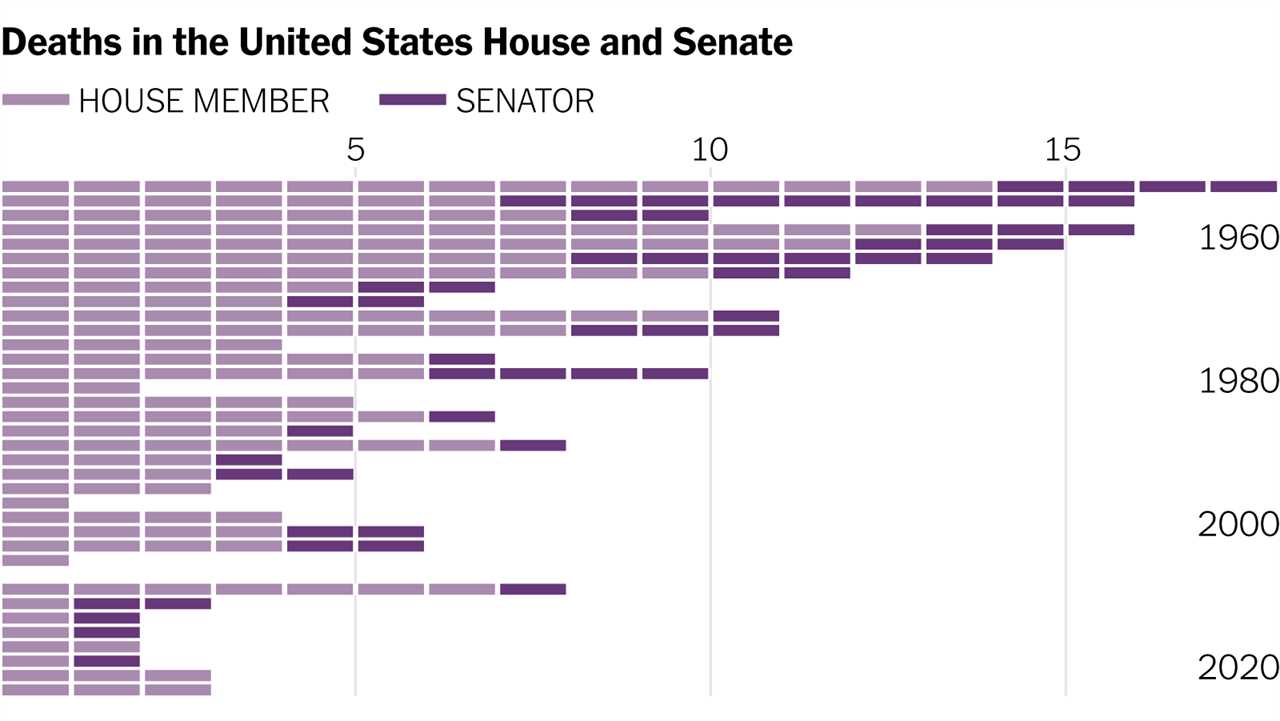
On March 21, 1950, an Illinois congressman named Ralph Church suddenly slumped in his seat while testifying before a House committee. His colleagues rushed to administer aid, but he was pronounced dead of a heart attack at 66.
He was neither the first nor the last member of Congress to die in office. “You look back in history, nearly one in 10 members of Congress have,” said Jane L. Campbell, president of the U.S. Capitol Historical Society.
That history has some Democrats worried that deaths or illnesses could derail President Biden’s efforts to pass ambitious bills through Congress, which his party controls by the narrowest margins in decades.
“Our ability to make good on Biden’s agenda is pretty much dangling by a thread,” said Brian Fallon, a former aide to Senator Chuck Schumer, the Democratic majority leader. “I don’t think it’s uncouth to talk about it. I think it’s a reality that has to inform the urgency with which we approach those issues.”
As the accompanying chart shows, more than 1,160 sitting members and members-elect have died from accidents, disease and violence since the first Congress met in 1789, according to a New York Times analysis of House and Senate records. They include multiple House speakers, famed senators and two former presidents: John Quincy Adams and Andrew Johnson, who both returned to Congress after leaving the White House.
The pandemic and the Jan. 6 Capitol uprising fueled fears that this Congress was particularly vulnerable to such deaths. But with most members vaccinated and security tightened, old age may be a bigger threat. The average age of a sitting senator is 64, and for a representative it’s 58, making this Congress one of the oldest.
“Heart disease and cancer are really the two most common causes of mortality, and they are both things that increase with age,” said Dr. Ezekiel Emanuel, a professor of medical ethics and health policy at the University of Pennsylvania, who served on Mr. Biden’s pandemic task force before he took office.
On average, 10 lawmakers have died in each two-year Congress: seven House members and three senators. Deaths peaked in the 1940s, and have slowed in recent decades. But every Congress except two has lost at least one member.
In the House this term, deaths have already affected the parties’ close margins. Three members — Ron Wright of Texas and Representative-elect Luke Letlow of Louisiana, both Republicans; and the Democrat Alcee Hastings of Florida — have died, the most in a Congress in its first three months since the early 1980s. (Mr. Wright and Mr. Letlow died from Covid-19.)
Health problems have also dogged the Senate. Patrick Leahy, 81, Democrat of Vermont, was briefly hospitalized in January. Thom Tillis, 60, a North Carolina Republican, underwent cancer treatment. Questions have been raised about the health of Dianne Feinstein, 87, a Democrat who has represented California since 1992. Vermont’s other senator, Bernie Sanders, 79, had a heart attack in 2019.
In the most extreme case, deaths could end Democrats’ ability to pass legislation without Republican support — or even flip control of either chamber. That’s more likely in the evenly divided Senate, where a single Democratic vacancy could hand Republicans committee gavels and the power to schedule votes until a Democratic successor was appointed or elected.
A serious illness could also upset the party’s delicate legislative arithmetic. “Schumer needs all 50 votes,” said Mr. Fallon, now the executive director of Demand Justice, a progressive advocacy group focused on the federal judiciary. “If somebody is laid up or is hospitalized for a long period of time and their vote’s not there, then having the majority is somewhat meaningless.”
It’s also possible that a special election or governor’s appointment could shift Senate control more lastingly. Several states require governors to fill vacancies with a temporary replacement of the same political party as the departed senator. But nine senators in the Democratic caucus represent states with Republican governors who can appoint anyone they choose. That could let a Republican governor name a Republican replacement, giving Republicans the majority, even if it may be temporary. (Six Republican senators represent states with Democratic governors who have similar authority.)
House vacancies are filled by special election, and relatively few seats are competitive, lowering the chances that deaths could alter partisan control. No special election to Congress so far this year has flipped a seat.
But special elections take time to organize; delays could further shrink Democrats’ single-digit margin for error. Though House control has never changed mid-session, Republicans could push to elect a new speaker and take over committees if vacancies forced Democrats below a majority of seats, said Sarah Binder, a George Washington University political scientist who has studied congressional deaths.
“There’s so much at stake for Democrats in losing control of one or both chambers midstream of a brand-new president with an ambitious agenda,” she said. “The loss of unified control would be devastating.”
Of course, deaths or illnesses could accrue to Democrats’ political benefit. The early retirement of the ailing Republican senator Johnny Isakson of Georgia in 2019 left his seat open. Kelly Loeffler was appointed to it and lost to Raphael Warnock in January, helping give Democrats their current majority.
Deaths have altered the balance of power, and changed American history, before.
In the 1930 midterm elections, Republicans narrowly won the House. But a combined 14 representatives-elect in the two parties died before Congress convened 13 months later, and growing discontent over the Depression helped Democrats flip enough seats to claim a majority. They used it to pass legislation — including economic relief, protections for organized labor and higher taxes on the rich — over President Herbert Hoover’s opposition, emphasizing his indifference to the Depression and bolstering the Democrat who ultimately defeated him: Franklin Roosevelt.
“I would not argue that Franklin Roosevelt would have lost in 1932 if it hadn’t been for the Democrats gaining control of the House,” said Andrew E. Busch, a professor of government at Claremont McKenna College. “But it definitely is the case that they established the groundwork for the New Deal and helped Roosevelt to distinguish his program from Hoover’s.”
More recently, the 2009 death of Senator Ted Kennedy of brain cancer — and Scott Brown’s upset victory to fill his seat — cost Senate Democrats their filibuster-proof majority. That forced the House to abandon its more progressive version of the Affordable Care Act and pass a stingier bill that had already cleared the Senate.
“Losing Kennedy’s seat forced Democrats to settle for a bill that had even more compromises than they had hoped,” said Jonathan Cohn, who recounts the passage of the A.C.A., also known as Obamacare, in a new book.
Mr. Kennedy’s death may have also indirectly empowered legal threats to Obamacare’s survival. The Senate version was hastily written and lacked a so-called severability clause, which protects laws from being overturned entirely if parts of them are ruled unconstitutional. That omission is now the reason a pending Supreme Court case could invalidate Obamacare in full. “The entire law is at risk because there’s no severability clause,” Mr. Cohn said.
Of course, past is not necessarily prologue. Congressional deaths have declined sharply over the last several decades, amid medical advances and lengthening life spans. And members may not be a representative sample. “Statistics are averages, and we’re dealing with individuals,” Dr. Emanuel said. Lawmakers “tend to be well off and well educated, and those are predictors for longer life expectancy than the average.”
But some of them appear to recognize the potential for deaths to help or hinder Democrats. Mitch McConnell, the 79-year-old Republican minority leader in the Senate, recently got the Kentucky legislature to change the state’s appointment rules, requiring the state’s Democratic governor to fill vacancies with a member of the departing senator’s party.
Still, recent history — including Ruth Bader Ginsburg’s death last September and the pandemic’s devastation — suggests that mortality can unexpectedly shape political outcomes. For today’s Democrats, moving quickly may be the surest way to prepare for the unthinkable.
“We have maybe a once-in-a-generation window to enact major reforms,” Mr. Fallon said. “We may not have a full two years to pace ourselves.”
Additional work by Lalena Fisher.
Did you miss our previous article...
https://trendinginthenews.com/usa-politics/whos-the-comeback-candidate-5-takeaways-from-the-mayors-race






